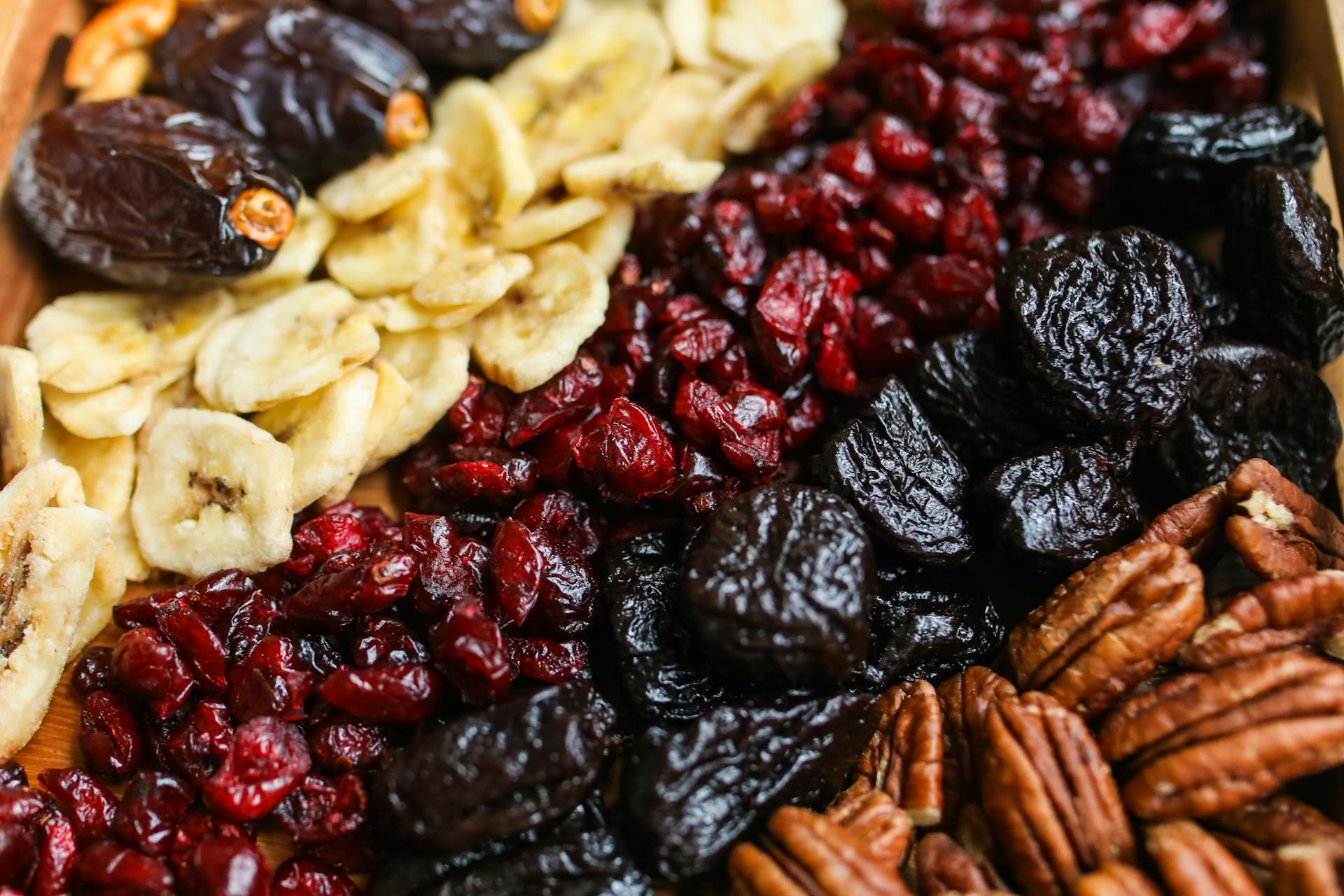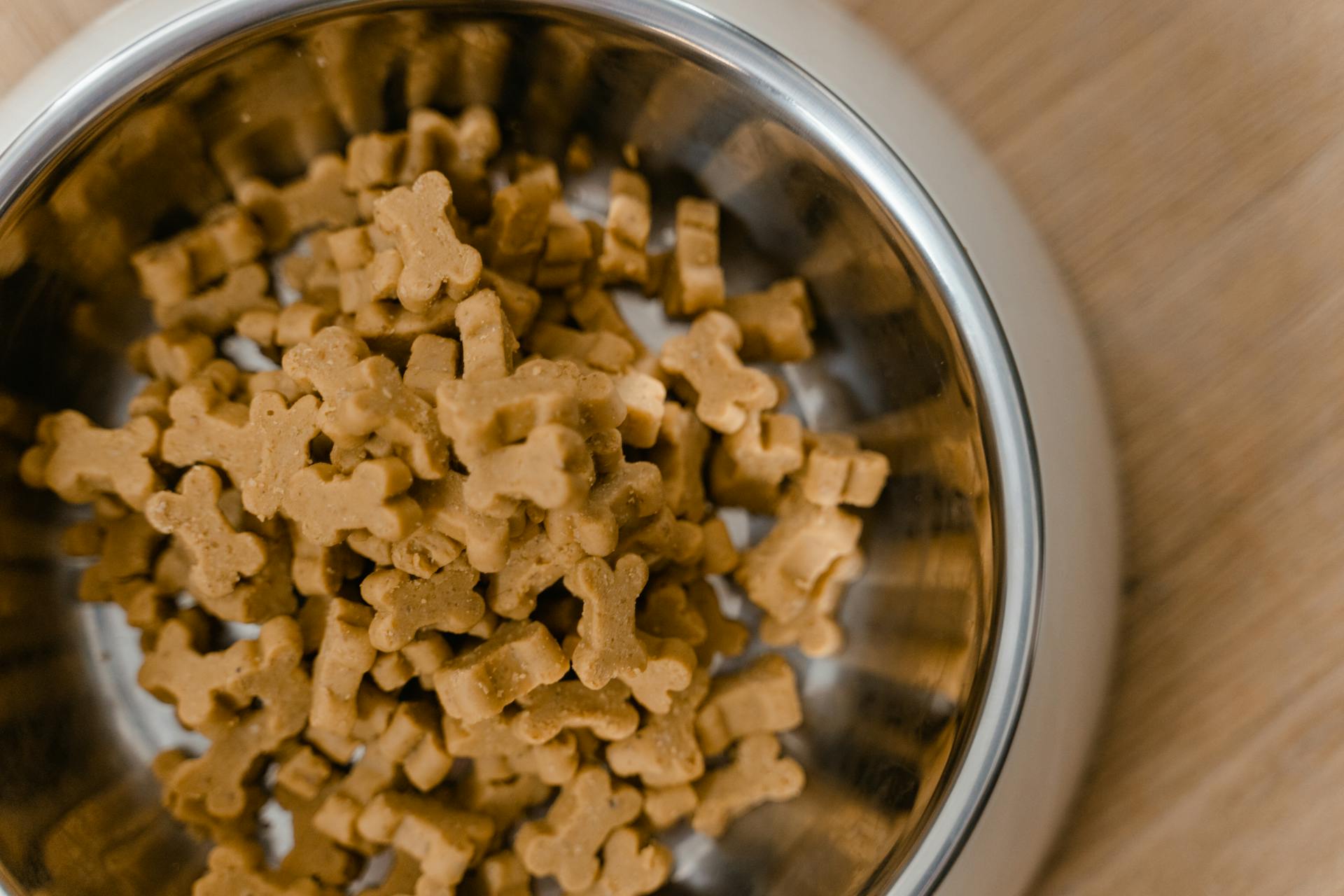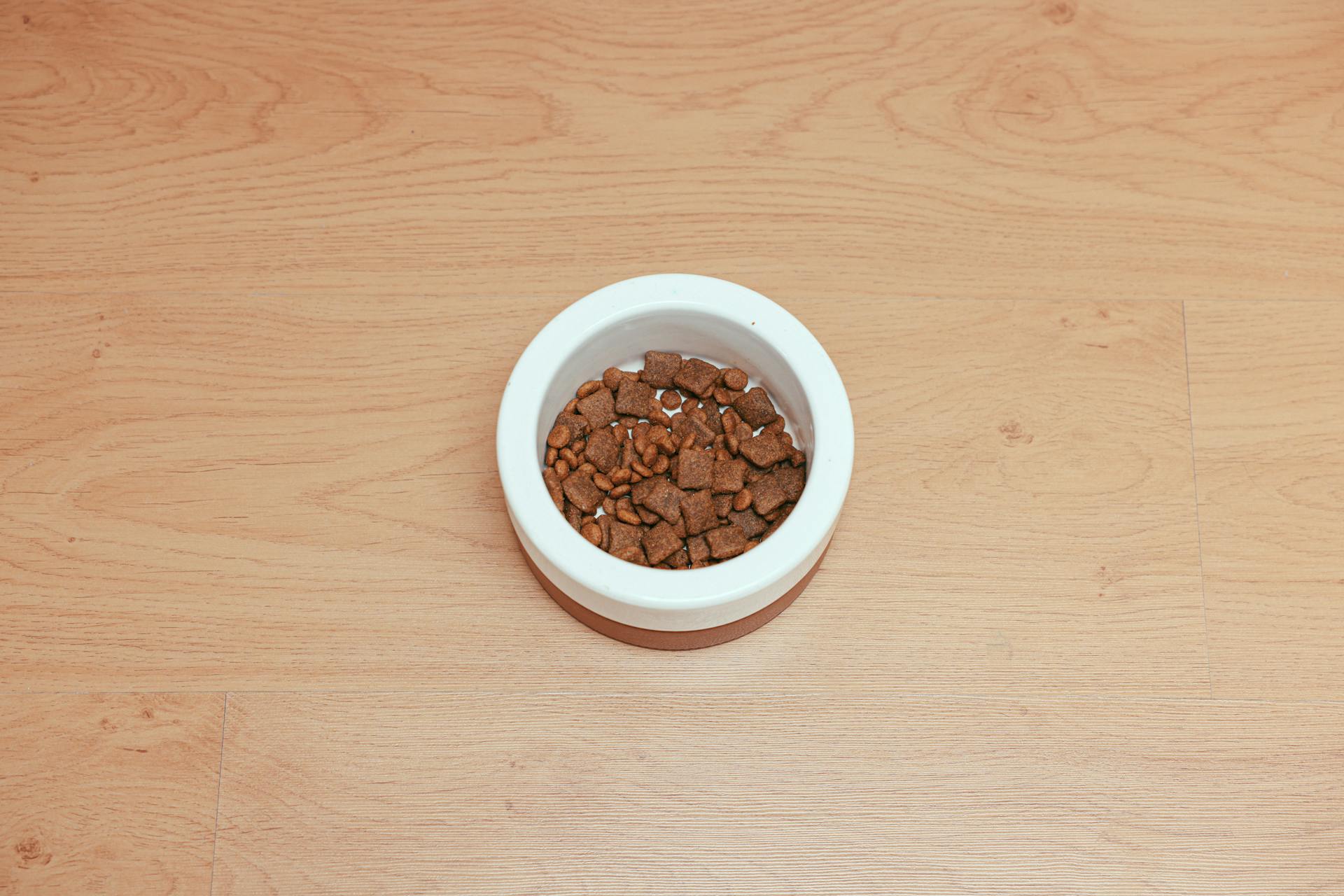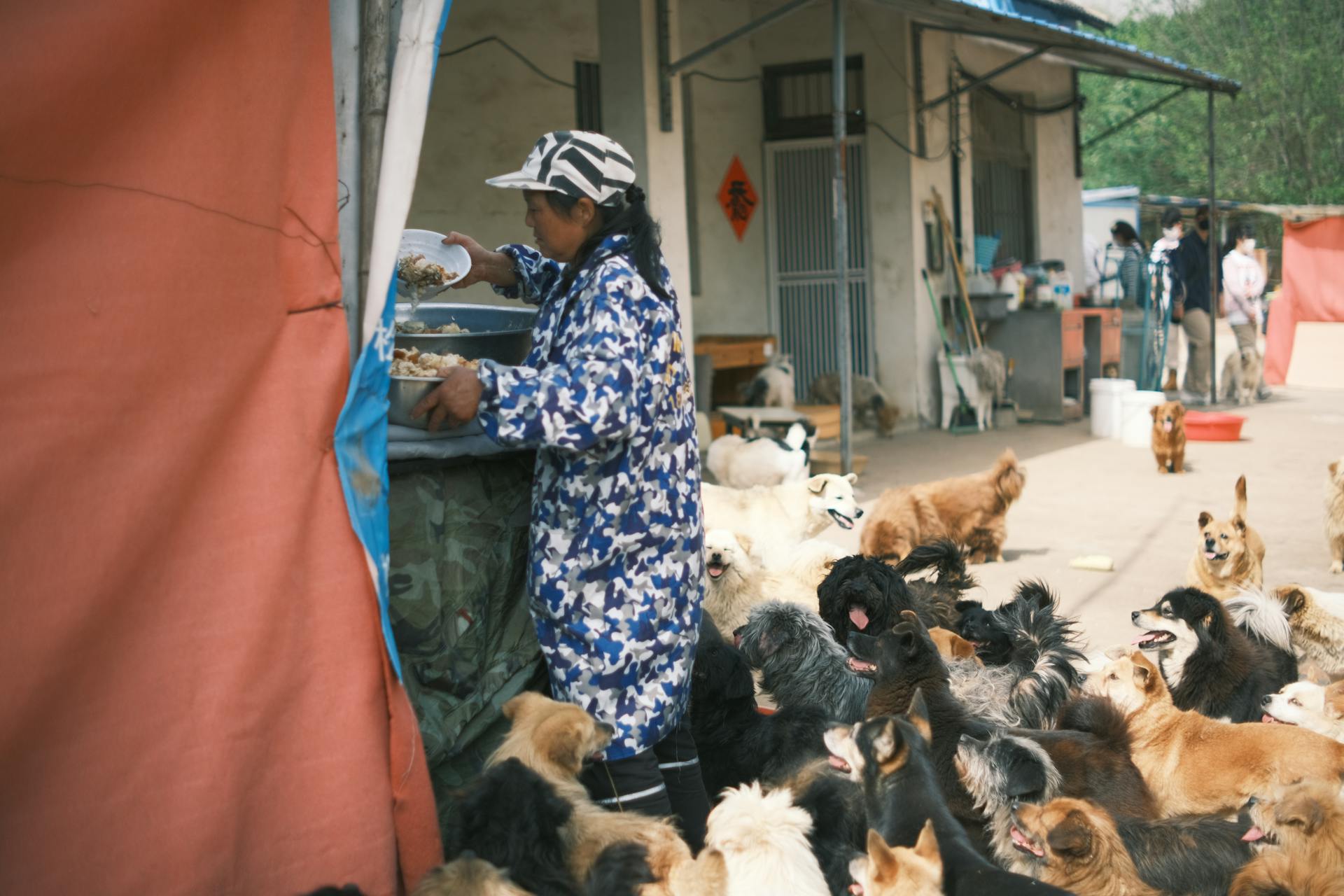
Freeze-dried food has gained popularity as a convenient and healthy option for dogs, but is it really good for them? According to research, freeze-dried food can be a nutritious alternative to traditional kibble, providing up to 90% of the nutrients found in fresh food.
Freeze-drying preserves the natural goodness of ingredients, making it an excellent choice for dogs with sensitive stomachs or food allergies. Studies have shown that freeze-dried food can be easily digestible, reducing the risk of gastrointestinal issues.
Freeze-dried food is also rich in protein, which is essential for maintaining a healthy coat and muscles in dogs. In fact, a study found that freeze-dried chicken contains up to 70% protein, making it an excellent option for dogs requiring high protein diets.
Consider reading: Is High Protein Dog Food Good for Dogs
What Is Freeze-Dried Food?
Freeze-dried food is a type of preserved food that's made by removing the water content from food using a vacuum and low temperatures. This process helps preserve the nutrients and flavor of the food.
Freeze-dried food is often compared to dehydrated food, but they're not exactly the same thing. Freeze-dried food is made by freezing the food first, then removing the water content, whereas dehydrated food is simply dried.
Freeze-drying helps preserve the nutrients in food, including vitamins and minerals. This is because water can cause nutrients to break down, so removing it helps keep them intact.
Freeze-dried food is also often preferred by pet owners because it has a longer shelf life than fresh food.
Explore further: What Nutrients Do Dogs Need in Homemade Dog Food
Benefits of Freeze-Dried Food for Dogs
Freeze-dried dog food is a great alternative to raw meat for pet parents who want to feed their dogs a raw diet but don't want to handle and prepare fresh raw meat themselves.
Freeze-dried foods are complete and balanced for all life stages, as long as they've been formulated to meet AAFCO standards. This means you can trust that your dog is getting all the nutrients they need.
One of the benefits of freeze-dried food is that it's easy to find high-quality, organic ingredients in these formulas, including grass-fed meats. Processing and additives are usually minimal, too.
Freeze-dried foods may be especially helpful for people who travel with their pets, since the drying process condenses fresh food down into a much smaller, lighter, and shelf-stable form.
Freeze-dried dog food can provide a shinier coat, healthier skin, better bone and joint health, cleaner teeth, smaller stools, and fewer allergic reactions.
Here are some potential health benefits of freeze-dried dog food:
- Shinier coat
- Healthier skin
- Better bone and joint health
- Cleaner teeth
- Smaller stools
- Fewer allergic reactions
Freeze-dried foods are also highly digestible, which can help reduce the risk of digestive issues, allergies, and other health problems in dogs.
Complete Nutrition
If you're feeding a freeze-dried food as your dog's whole diet, make sure to look for a product that states it provides complete nutrition for your dog.
Read the package carefully, as many freeze-dried foods are sold as toppers, which are meant to supplement other foods, not provide a balanced diet.
You might enjoy: Foods for Dogs with Diabetes
Freeze-dried foods that are designed as standalone diets will explicitly state that they offer complete nutrition.
You can't assume that just because a freeze-dried food is labeled as "complete nutrition", it's suitable for your dog's entire diet.
If a product is labeled as a topper, it's meant to be added to your dog's regular food, not used as a replacement.
Convenience and Ease of Use
Freeze-dried raw food is incredibly convenient. It has a longer shelf life that doesn't require a freezer, making it easy to scoop and serve.
Traveling with your dog just got a whole lot easier - you can bring along a bag of freeze-dried raw food without the hassle of packing a cooler. This is especially great for camping or backpacking trips, where the light weight of freeze-dried food is a big plus.
Freeze-dried food is also easy to order online, with light and affordable shipping options.
Convenience
Freeze-dried raw food is just as convenient as kibble because it has a longer shelf life that doesn't require a freezer.

Just scoop and serve - it's that simple. No need to worry about thawing or reheating, just pour it into your dog's bowl and you're good to go.
Traveling with your dog just got a whole lot easier with freeze-dried raw food. No more trying to fit a big cooler in the car to keep frozen food from spoiling on the road.
It's also perfect for camping or back-packing with your dog because it's incredibly light. Your dog can even carry her own food in a backpack!
Buying freeze-dried food online is a breeze, and it's also a cost-effective option since it's light and cheap to ship.
Take a look at this: Best Dog Food for Dogs with No Teeth
How to Feed
Feeding your dog freeze-dried dog food is straightforward, but it's essential to follow the specific instructions listed on the food you choose. Some formulas are meant to be served as-is, while others require rehydration by crumbling into warm water.
Freeze-dried dog food is widely available, making it easy to find and purchase. You can find it at big-box pet retailers, small independent pet health food stores, or even online.
For more insights, see: Freeze Pet Fresh Dog Food

Some freeze-dried foods can be mixed in or sprinkled on top of regular food, making mealtime more interesting for your dog. Others can be doled out as quick treats.
Adding water to freeze-dried food makes it bulkier and more filling, which is especially important for dogs who don't drink much water on their own.
Rehydration
Rehydration is a great way to make freeze-dried food more palatable for your dog.
Some freeze-dried foods are best rehydrated with water or broth to bring out their flavor and texture.
Using bone broth for rehydration adds extra nourishment to your dog's meal.
It's generally a good idea to rehydrate the food to make it more filling for your dog.
My dogs don't like mushy foods, so they prefer the crunchy freeze-dried food straight out of the package.
For another approach, see: Chicken Broth for Dogs Pets at Home
Raw Materials and Preservatives
Freeze-dried dog foods typically contain a preservative as an extra precaution against spoilage.
Some common preservatives used are mixed tocopherols, which are extracts of vitamin E, and rosemary extract, an oily residue extracted from rosemary plants.
Mixed tocopherols are technically synthetic but are an effective antioxidant with no evidence of harmful side effects.
Rosemary extract prevents oxidation of fats and protects flavors, and even though rosemary essential oil can be risky for dogs with seizures, the amount used in food is tiny and safe for most dogs.
The amount of rosemary extract used is typically less than 1% of the food, making it safe for most dogs.
What Is Raw?
Raw food for dogs is a topic of interest for many pet owners. Raw dog food is minimally processed and retains the nutrients and enzymes of raw food.
Freeze dried raw dog food is made by removing the moisture from raw meat and vegetables. This process helps preserve the nutritional integrity of the food.
Freeze dried raw dog food is an excellent source of essential minerals, vitamins, and proteins. It's highly digestible and can help improve overall health and wellness in dogs.

The ingredients are cooked and dried before being packaged, which gives the food a longer shelf life. This makes it a convenient option for pet owners who want to provide a balanced diet to their pets.
Here are some popular freeze dried raw dog food options:
- Instinct Freeze-Dried Raw Meals Cage-Free Chicken Recipe Grain-Free Dog Food
- Stella & Chewy's Surf 'N Turf Dinner Patties Freeze-Dried Raw Dog Food
- Wag Freeze-Dried Raw Single Ingredient Dog Treats Chicken Breast
- Stella & Chewy's Stella's Super Beef Meal Mixers Freeze-Dried Raw Dog Food Topper
Choosing Raw Materials
Choosing raw materials for your dog's diet can be a bit tricky, but it's worth getting it right. The raw feeder's "scientific" adjustment method can be a useful tool - if your dog gains weight, cut back a bit, and if she loses, add a bit extra.
Some raw dog foods are freeze-dried, which can be a convenient option. To choose a freeze-dried raw dog food, follow the raw feeder's adjustment method, as mentioned earlier.
A Word About Preservatives
Most freeze-dried dog foods contain a preservative as an extra precaution against spoilage. You may see mixed tocopherols or rosemary extract on the ingredient list.
Mixed tocopherols are extracts of vitamin E, technically synthetic but effective antioxidants that help preserve the food. There's no evidence of harmful side effects.
Rosemary extract is oily residue extracted from the leaves of rosemary plants, preventing oxidation of fats and protecting flavors. The amount used is tiny, and for most dogs, it's safe.
Cons of
Freeze-dried dog food can be quite expensive, with prices ranging from $30 to $50 for a 1 lb bag. This is due to the costly equipment and laborious freeze-drying process that takes about 2 days to complete.
The cost is a significant drawback, especially when compared to traditional kibble or canned food. However, the high price point is partly due to the convenience and long shelf life that freeze-dried foods offer.
Some freeze-dried brands may be comparable in price to raw brands when rehydrated, but they're still more expensive than kibble or canned foods. You can consider buying bigger or bulk sizes to save some money.
A fresh viewpoint: What to Feed Dogs If Out of Dog Food

Freeze-dried dog food also requires a rehydration process, which can be a bit of a challenge for some dogs. They may not readily accept the texture or taste of rehydrated food, so it may take some trial and error to find a brand or flavour that suits your dog's preferences.
Adding water to freeze-dried food is especially important for dogs who don’t drink much water on their own. It's also crucial for dogs with digestive issues to ensure that the food is properly rehydrated to avoid potential digestive issues.
Safety and Comparison
Dogs are surprisingly resilient to bacteria, thanks to their acidic digestive tracts that can handle what would make humans sick.
Their tolerance to bacteria is quite impressive, considering the stuff they often sniff out and swallow on walks or in the wild.
However, many manufacturers still use high pressure pasteurization (HPP) to eliminate pathogens, likely due to the Food Safety Modernization Act's zero-tolerance policy for bacteria in pet foods.
This "kill step" doesn't cook the food, but research shows it only results in slight nutrient loss.
Some companies opt for a "test and hold" approach, where they don't release each batch of food until it's safety-tested.
Take a look at this: Dog Food Safety
Safety

Dogs tolerate bacteria much better than humans, thanks to their acidic digestive tracts that keep most bacteria at bay.
Their ability to snack on questionable items on walks or in the wild is a testament to this.
Downsides of Pet Formulas
Freeze-dried pet food can be quite pricey, with an average cost of $33 per pound, compared to $10 or $11 for air-dried or dehydrated pet foods.
Many veterinarians also have concerns about the potential for illness-causing bacteria in freeze-dried pet food. According to veterinary nutritionist Dr. Megan Shepherd, freeze-drying alone is not an effective way to eliminate microbial pathogens like Salmonella, E. coli, and Listeria.
Some manufacturers may claim that their products are pathogen-free, but it's essential to verify this information. AAFCO, which sets standards for pet foods in the U.S., warns that any raw foods you're feeding your pup could put humans in the house at risk for illness.
The cost and potential health risks are significant downsides to consider when evaluating freeze-dried pet food.
Freeze Dried vs Kibble Considerations
Freeze-dried food has a longer shelf life than kibble, with some products lasting up to 25 years when stored properly.
Kibble, on the other hand, typically has a shelf life of 1 to 2 years.
Freeze-dried food is also less prone to spoilage due to its low moisture content, which makes it a better option for emergency food supplies.
The moisture content of kibble can lead to mold and bacterial growth, especially in humid environments.
Freeze-dried food can be rehydrated with hot water, making it a convenient option for camping or backpacking trips.
Kibble, while convenient, can be heavy and bulky to carry on long trips.
Freeze-dried food is often more expensive than kibble, but its longer shelf life and convenience make it a worthwhile investment for some pet owners.
Types and Options
Freeze-dried dog food comes in various formulations, including high-protein options.
You can also find freeze-dried products with high-fat and moderate-protein combinations.
Some freeze-dried dog foods are similar to traditional kibble, containing carbs like potatoes and legumes.
The proteins in freeze-dried dog food are considered raw, which is a key benefit for many pet owners.
In some cases, the starches in freeze-dried dog food are also raw, making it a more natural option for dogs.
Explore further: Dog Food for High Energy Dogs
Frequently Asked Questions
What are the disadvantages of freeze-dried food?
Freeze-dried food can be more expensive than other preservation methods, and some ingredients may require special treatment to withstand the freeze-drying process. Additionally, freezing can damage certain foods, affecting their quality and nutritional value.
Sources
- https://www.dogsnaturallymagazine.com/freeze-dried-dog-food-the-pros-and-cons/
- https://www.greatpetcare.com/dog-nutrition/freeze-dried-dog-food-the-pros-and-cons/
- https://www.thedodo.com/dodowell/freeze-dried-dog-food
- https://www.k9magazine.com/freeze-dried-raw-dog-food-vs-kibble/
- https://gooddogpeople.com/blogs/dog-talk/freeze-dried-dog-food-are-they-any-good
Featured Images: pexels.com


